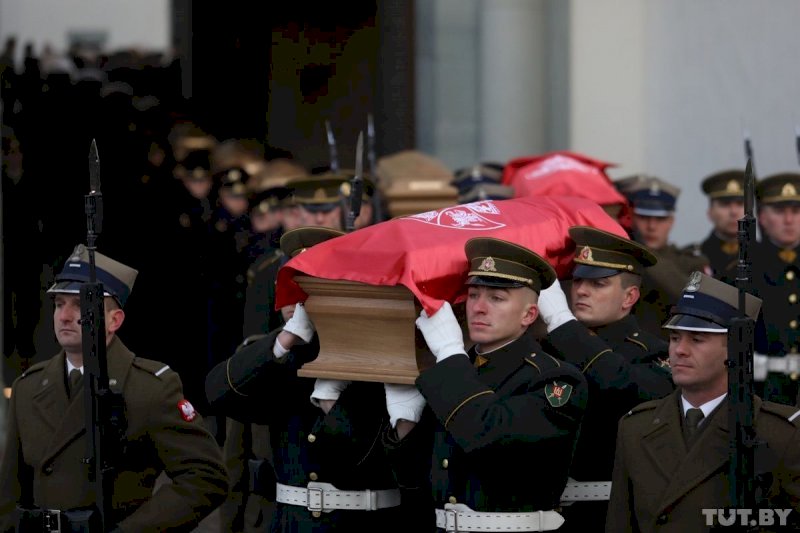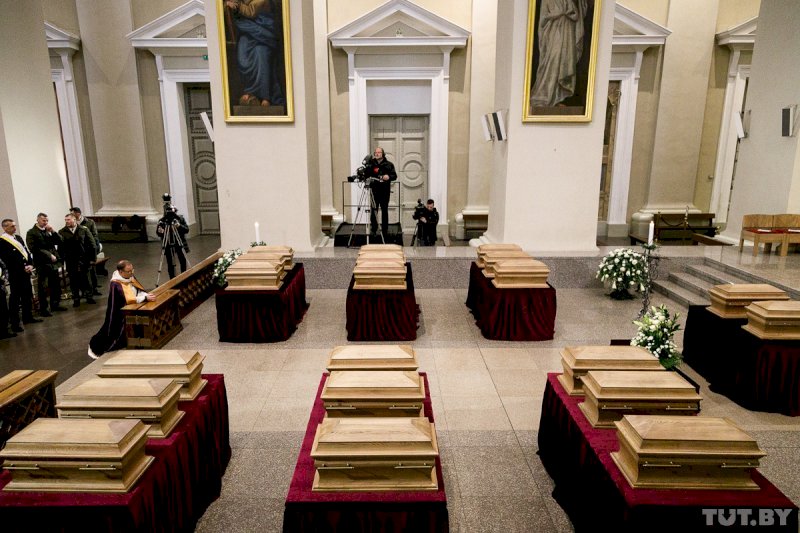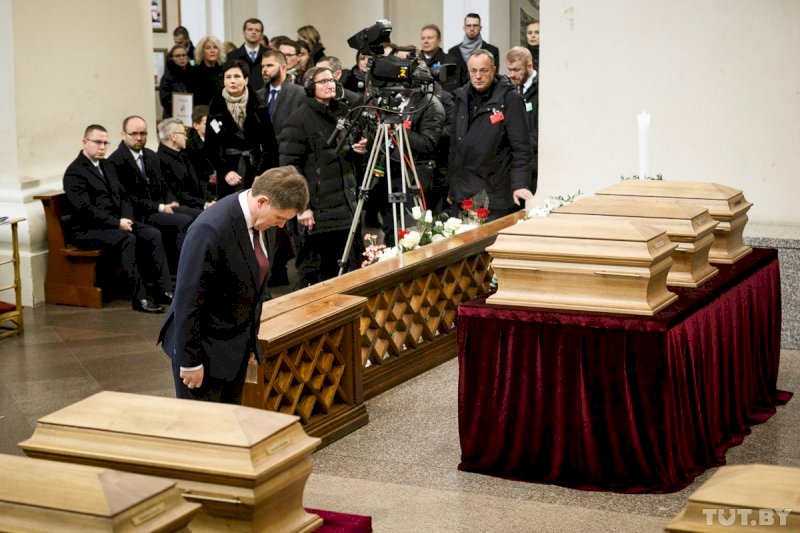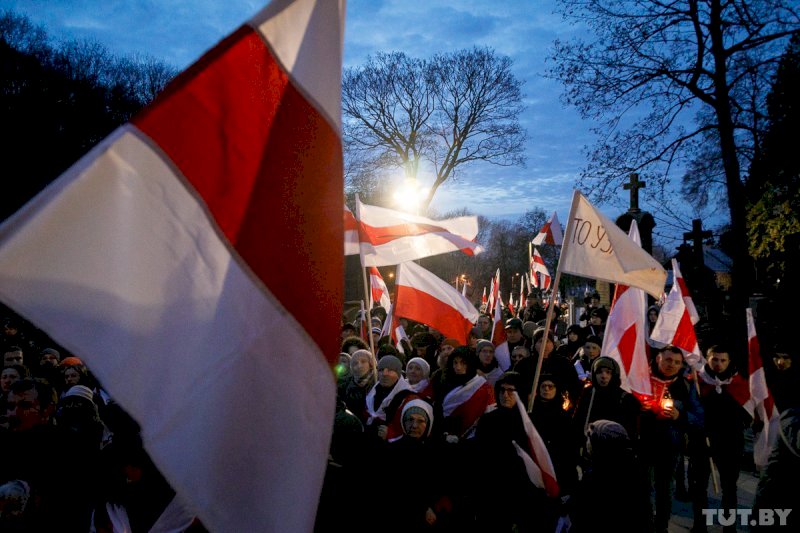Belarusians In Vilnius: Today We Feel Really United
- 25.11.2019, 16:13
- 3,989

People were saying farewell to Kalinouski and the rebels.
On November 22, Vilnius seemed to have returned to the past. For one day, its streets were again belonging to the Belarusians, who came to say farewell to their hero Kastus Kalinouski. Having cast aside their business affairs, thousands of people were bidding final farewell to him and other rebels. The funerals lasted all day, and there was no mourning or sadness in them. Tut.by reports about how it all was happening.
Early morning. Vilnius. There are still lanterns burning in Pylimo Street: the remains of the night darkness are melting down. Christmas trees shine in shop windows and wink, reminding passers-by that Christmas and New Year's Eve are coming up.
It is quite easy to recognize Belarusians on the sleepy semi-desert streets of Vilnius. They hurry (it's clear where to), are wrapped as warmly as possible (and often - in white-red-white flags), folding flagpoles look out of backpacks.

The removal of coffins with the rebels' remnants is planned for 8.30 a.m., and many people have already gathered in the city's cathedral square by then.
- That's what we have been travelling for, - a group of Belarusians says. - To get up early, to come here and bid farewell to the rebels, that is the smallest thing we can do for them today.
The remains of 20 rebels, including the leaders of the uprising, Kastus Kalinouski and Zygmunt Sierakowski, were placed in small coffins made of natural wood. They were taken out of the palace of the rulers of the Grand Duchy of Lithuania to the beating of drums and the ringing of bells. This was probably the most powerful moment of the day. Here it is, our tragic history, is carried by the Lithuanian and Polish military.

A lot of participants in the ceremony were talking about how valuable and important it would be to see the Belarusian guard of honor in Vilnius. They were doing it in different tones: with indignation, regret and sadness. They were talking - but couldn't change anything.
At 9 a.m. the cathedral church opened its doors to all those who came to bid farewell to the rebels. The spacious hall quickly filled with people. A lot of people, who came in, crossed themselves. Some of them knelt down at the entrance and were quietly praying.
Time went by and the flow of people did not die off - it only grew hour after hour.
Here comes Pavel Seviarynets with a bunch of white and red roses in his hands.
- Just like our white-red-white flag, - the politician and writer explains.
- And why do you have three of them?
- Heroes don't die.
It is impossible not to notice a woman and a young girl in the seemingly endless flow of people. They are holding spruce wreaths with chrysanthemums tied with white and red ribbon. We start a conversation - it turns out that these people are the heirs of "dark-browed Maryska, my dove", whom Kastus Kalinouski was in love with.

Today Eva Yamont and her daughter Hanna live in Paris. And they could... I wonder how the history would have turned, if their great-grandmother's sister's fiancé hadn't been executed? What kind of life would be in Belarus today? One can assume and fantasize for a long time, but it is absolutely useless.
- Marusia and Alena, whose fiancés were rebels, were sisters of my great-grandmother, - Eva explains. - There were five children in the family, and they were exiled to Siberia together with their parents. After Marusia moved from Siberia to Warsaw, she got married, but she had no children. Alena got married in Siberia. She gave birth to a daughter in prison. Then to a son. But she fell ill with tuberculosis and soon died.
"Today we all feel truly united"
What happened on November 22nd looked like a revived history, it was said by a lot of participants in the ceremony. The execution of Kalinouski and his "lads" took place 155 years ago. This event has already become the past, but suddenly, thanks to a landslide and Lithuanian archaeologists, it has become the present, which thousands of people are witnessing.
- This is indeed a historic event, - young people from Mahiliou, whom life has scattered across different countries, say in one voice. Today Kalinouski has brought them together in Vilnius.
Hanna is 17 years old, she is a student. Today she sees so many white-red-white flags for the first time in her life.
- Being here today is an opportunity to feel yourself a Belarusian, - she says.

It is important for Hanna and her friend to be at the funeral of the rebels, because for them it is "an opportunity to feel that we are really Belarusians".
- At this event, I see that there are a lot of people who think the same way as I do. Today, we all feel truly united.
On November 22, the weather decided to mix everything it could: the frost of minus two degrees, the sun, the wind and the rawness at the same time. But it scared few people - for two hours, while the service was on in the cathedral, thousands of people were standing in the main square, watching what was happening in the temple on the screens. Some people periodically hid in the cafe to get warm - and went outside again.
There were many familiar media faces on the square near the cathedral: politician Ryhor Kastusiou, human rights activist Ales Bialiatski, artist Ales Pushkin and his son, sculptor Henik Loika, writer Uladzimir Arlou and others. But the most interesting thing was to find out who all those other people who came to say farewell to Kalinouski under white-red-white flags are. Programmers, entrepreneurs, technologists, chemists, waiters, students, teachers, salespeople, doctors, lawyers, mechanics - almost the entire spectrum of the Belarusian labor market in one place.
Although the presidents of the two countries were in the cathedral, it did not cause discomfort to those present in the square. No inspection, no jamming of mobile phones. At the most, there were policemen in civilian clothes who could be identified by badges and policemen with dogs in the crowd.
The speeches of Andrzej Duda, Gitanas Nauseda and Ihar Piatryshenka were taken differently in the square - from applause to shouting "Long Live Belarus" and "shame".
"I really want our children to see it and learn to love the country where they were born ".
The procession moved to the street half an hour late. A long live corridor, behind which former Lithuanian President Dalia Grybauskaitė walked unnoticed, was waiting for it. A woman in a cap and a scarf of colours of the Lithuanian flag noticed the former president, quickly rushed towards her, gave her a hand - Grybauskaitė smiled, offered her hand in reply and they exchanged a couple of phrases.
Siarhei from Zhlobin came to the reburial ceremony with his wife and son. He drove almost all night to be in time for the funeral: 210 kilometers to Minsk, then to Vilnius plus four hours of waiting at the border.
- We bring up children properly: we teach the language and modern Belarusian traditions.

By the way, there were a lot of children in the square and in the flow of people who moved after the funeral procession to the Rasos Cemetery.
For example, Mikalai came to Vilnius with two children. One of the kids is not even able to walk yet.
- This event is too dear to us. And it is really large-scale. Today we were discussing who else could be ranged with Kalinouski. We came to the conclusion that, probably, it is only Skaryna. The most interesting thing is that after 150 years this story is still alive. And it is too important to be missed by a person who loves Belarus. I really want our children to see it and learn to love the country where they were born.
Lithuanian, Polish and white-red-white flags have merged into a single colorful stream, in which everyone felt equal and involved in the event.
- You speak Polish, I'll speak Belarusian and we'll understand each other, - two men, who, obviously, just met, tell each other.
- Okay. Then explain to me what "shame" means, - the Pole asks.
The spouses Kim and Lesya are ahead of them. He has a white-red-white flag on his shoulders and she - a Ukrainian one.
- I cannot call this ceremony a reburial. It's more like a funeral, because Kanstantsin and others were just thrown into the pit. Today we will put the foundation of our nation, partly Lithuanian, partly Polish and partly Belarusian, in the ground. Perhaps, something bigger will grow out of it.
Here, in the flow, we also meet the hero of our road report - programmer Sasha. Today he decided to speak Belarusian. It sounds very good.
The procession stretches for many hundreds of meters. Local Vilnius residents are surprised at the number of white-red-white flags, among which there are no official Belarusian flags.
The final journey of the rebels ends in the chapel at an ancient Vilnius cemetery - the Rasos Cemetery.


















